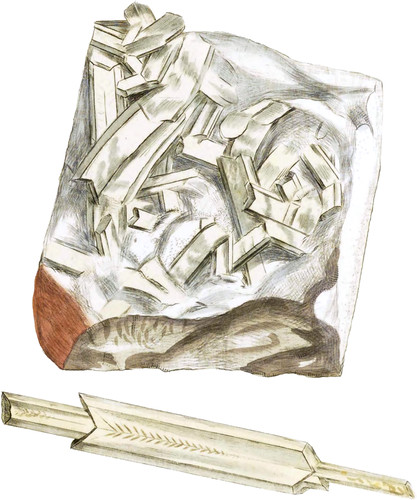 Enlarge
Enlarge
British Mineralogy
Sulphate of Lime, or Gypsum
- Class 2. Earths.
- Order 1. Homogeneous.
- Gen. 3. Lime.
- Spec. 3. Sulphate of Lime.
Gypsum, when crystallized on an amorphous gangue, is not very generally known, and has been very little noticed by authors; common Selenites only have been placed among the crystallized varieties*.
The present specimen is from Derbyshire, where largish blocks or lumps of amorphous Gypsum are found, often very white, looking like fine Carrara Marble, and sold for various purposes, as making what some call Alabaster figures, turned candlesticks, imitations of fruit, &c.† When the workmen are cutting it, they frequently find hollows including the crystals; but these do not often come into the hands of the curious. The white face of the hollow has often a snowy appearance, and is finely grained, upon which the pellucid crystals look sometimes very beautiful. The crystals are generally more clear and delicate than the Selenite, not having clay among them; and this is all the difference between them, since they are liable to the same forms of crystals, which are composed of opposite trapeziums, and are somewhat undulated, the same, with some variations, as the figure beneath, which comes from Oxfordshire, and is commonly called prismatic from its long columnar appearance; this is evidently mixed with clay, as the lower figure of tab. 67.
This sort of Gypsum is said to be found in masses of different sizes, but seldom larger than three or four feet in thickness; they are generally rugged, and broader than they are thick.
The antients are said sometimes to have used the transparent Gypsum in the place of glass in windows; whence it has been confounded with Mica and Talc—see tab. 180, 181, &c., which substances are still often confounded, although so distinct, as I presume this work now clearly explains.
The temple of Fortune at Seia was built of this stone, and without windows. The semi-transparency of the Gypsum admitted the light, and Pliny said that the temple appeared as if lighted from within‡.
Some specimens of the cry&tallized kind have lately been found at Alstone Moor on blende. See, and by some means got the title of Asbestos, They are sold in moderate pieces for a guinea each, or perhaps more, as the dealers may be more or less acquainted with the subject.
- * Crystallized Selenites—see tab. 67, are said to want a little Carbonate of Lime to make plaister, but the other varieties have naturally a sufficiency.
- † The less solid pieces serve, when burnt, for casting plaister figures, and for inferior purposes.
- ‡ Haüy 2.290. In Warwickshire, lam told that Gypsum has been used for building the outside of houses; where it is burned with wood for that purpose, and the whole mixed up together, giving it a greyish cast. It is said to be extremely durable, and is carefully saved when a house is on any occasion pulled down, as it is still more durable even if it has lasted centuries in the first instance.

